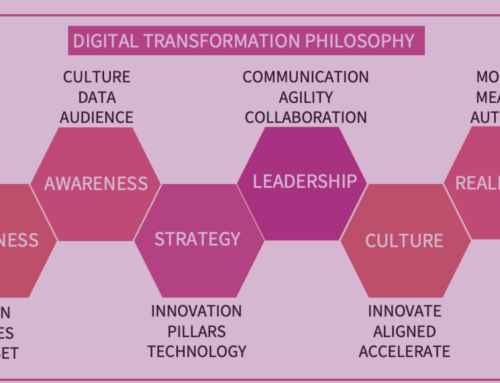“Warren…Mate,” I hear you say. “We know lockdown has been tough, but there’s no call to give up on digital leadership. It’s more important than ever!”
Good. I’m glad you’ve been paying attention.
For years, we’ve mostly been talking about UX (user experience), and CX (customer experience), and how they need to drive every aspect of your digital first business.
But now there’s a new ‘X’ that needs your digital leadership, and it’s all about brand.
BX= Brand Experience.
Sometimes, when I talk about brand, I get the sense that people are glazing over a bit. That they either see ‘brand’ as mostly about their VISUAL brand (the logo, colours etc) or that they believe brand is something only the bigger players to worry about.
But I’m here to tell you that, if that’s you, it’s time to snap out of that and get brand-savvy, because in the digital world we live in, the only thing differentiating between you and your competitors could be your brand. And, when we’re talking about digital first business, that means there could be a whole lot of BX you need to be paying attention to.
What’s the difference between CX and BX?
The idea of ‘brand’ first began as a way of stamping ownership on something. It was a simple mark (or logo). Then it gradually evolved to mean a set of associations with a particular company or product. Companies would make a huge effort to ‘own’ not just their logo, but certain differentiating colours, images, typefaces and styles. During the course of the 20th century, that evolved further – with certain brands become associated with emotions, values and brand promises.
When we talk about ‘brand thinking’, we’re looking to establish an actual (or perceived) difference from our competitors, or give customers a reason to believe that our offering is of a higher value than others. Think of automotive brands, where virtually the same vehicle can be seen as a mid-range purchase or have a prestige badge put on it, and acquire all the associations of higher quality engineering, better customer service, luxury, or whatever that brand is known for.
Brand is all about establishing differentiation – or seeming to be different.
Then we have customer experience (CX)
The concept of customer experience as mainstream really took off over the last 40 years or so, and is all about finding ways to continuous improve how you provide products and services on-demand, with an element of added value.
Retailers are a good example. The ‘in-store’ experience, from the environment to the staff to the way your purchases were wrapped became all-important.
Then came the rise of the internet. It’s been around a while, but we all know how much events of 2020 have increased the number of customers purchasing goods and services online. Many more businesses are now looking at a future where their customers ONLY interact with them digitally.
In the pre-digital world ‘owning’ your brand was largely a matter of cash. If you had the budget for advertising, you controlled the message. And control was what it was mostly about – strong brands were those who were consistent about what they said, and how and where they said it.
But these days that power and control is more in the hands of your customers. It is what they say about you that counts. Trust in advertising messages is falling, and customers are more concerned with authenticity and ‘purpose’ – why a company exists, and the value they offer besides selling whatever it is they do. You no longer own a strong brand, you earn it.

BX brings together the concepts of brand and customer experience to create a unique way, and a strong reason, for your customers to interact with you.
One simple way of defining the difference between CX and BX is that, whilst CX focuses on ‘making people want things,’ BX focuses on ‘making things people want’.
What makes a great BX?
It’s important to understand that BX doesn’t replace brand or CX. It’s more of a collaboration between elements of both. Great brands have always been (and remain) about the experience, and BX packages brand and CX up together. If you’re aiming for a great BX, you still need to create and understand your brand.
Nor is it something you do ‘to’ your customers. They are no longer passive ‘consumers’, so your BX is something you do ‘with’ them.
From brand, BX takes your purpose and the things that make you unique, creating an experience which is uniquely ‘you’. Your BX should be as ownable as your logo, colour scheme or brand story, and should be interwoven with every single customer interaction.
From CX, BX uses the focus on the quality of your product/service, customer service experience.
By focussing on BX, you are aiming to create something which:
- leads to engagement, ideally in a surprising or memorable way
- is ownable, and differentiates you from your competitors
- is cohesive and consistent across any type of interaction
- will be loved by your customers
You also need to consider, in a world where customers are increasingly focused on purpose, what the positive impact is that your brand offers to the world, and how that is built into your BX.
How do you approach creating a great BX?
You probably won’t be surprised to learn that it’s all about data.
Every customer interaction creates data. You use this data analyse and improve your customers’ experience. You collect more data…
What you’re looking for is data on four key components.
- Is absolutely every touchpoint with your customer of the same high quality, whether it’s your website, social media channels, live chat or packaging?
- As well as the same high quality, do all your communications use the same voice, tone and message? And are those messages authentic? Today’s customer will spot it quickly (and probably call you out on it) if it’s not.
- Brands no longer have a customer base, they have a community. Your customers know who you are, and they know (or can find out) who your other customers are. Their BX will influence how they interact with this community and whether they stick around. Get it right, and your brand will resonate with them, and they will aspire to be a part of it.
- When you get it right, and when they are ready, they will buy from you.
So a great BX is all about giving the customer what they want?
Not necessarily.
As Henry Ford never actually said, “If I’d asked people what they wanted, they would have said ‘faster horses.’”
If you listen only to what your customers tell you they want, you may miss opportunities to innovate.
If you respond to every customer demand or criticism, you risk devaluing (or at least lessening the differentiation of) your brand.
Your BX needs to be built on a solid understanding of your brand’s foundations – as we said earlier – its values, personality, voice and core purpose.
Knowing what your customers want and expect from you is key, of course. A recent Accenture study showed that:
“More than half of Gen Y and Z consumers, compared to 37% of other consumers, say they have shifted a portion of their spend away from their current service provider when a company disappointed them due to its words or actions on a social issue, and that “nearly half of Gen Y and Z say they prefer brands that make them feel part of something bigger and connect people around common causes or beliefs.”
But that doesn’t mean you should dilute your brand by trying to please everyone. You’ll be more likely not to please anyone.
Is BX the future?
Very much so. CX is what’s been happening up to now, and where many brands are still playing.
BX is the long term future, and this is your opportunity to get in, get it right, and (potentially) get ahead of the curve with your competitors.
Ready to produce game-changing digital results in your business?
Subscribe to receive cutting edge insights on digital leadership and transformation- straight to your inbox
We do not sell or share your information with anyone.









